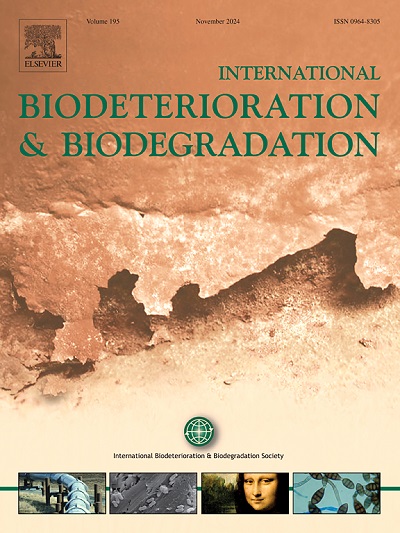Carbon steel Q235 corrosion protection by metabolism of Bacillus cereus biofilms in cooling water environment
IF 4.1
2区 环境科学与生态学
Q2 BIOTECHNOLOGY & APPLIED MICROBIOLOGY
International Biodeterioration & Biodegradation
Pub Date : 2025-05-22
DOI:10.1016/j.ibiod.2025.106124
引用次数: 0
Abstract
Multiple types of microorganisms have been reported to provide a corrosion protective effect on metals, but few cases under cooling water environments. This study addresses this research gap by employing Bacillus cereus (B. cereus) biofilms for carbon steel (CS) Q235 corrosion protection. The results demonstrated that the addition of B. cereus agent reduced the weight loss of CS Q235 by 92.38 %, increased the electrochemical impedance (Rct 21616.77 Ω/cm2) and lowered the corrosion current density (Icorr 16.8 μA cm−2). Surface analysis indicated that B. cereus cells secreted polysaccharides and proteins to form a biofilm. Such biofilm, combined with biomineralized corrosion products, formed a composite layer that prevented direct contact between CS Q235 and corrosive media. Moreover, metabolites of B. cereus biofilm associated with corrosion protective capacity were profiled and screen by untargeted metabolism analysis. A total of 376 metabolites were detected and genetic materials including uridine monophosphate (UMP) and guanosine monophosphate (GMP) were identified as the most critical metabolic principle for corrosion protection. These metabolites, which enriched in nucleotide metabolic pathways, was considered as metabolic mechanisms of corrosion protection. The B. cereus cells forming extracellular polymeric substance (EPS)-biofilm to alter the physicochemical properties of CS Q235 surface and repelled the attachment of corrosive microorganisms, thus hindered their multiplication and protected CS Q235 from corrosion in cooling water environment.
蜡样芽孢杆菌生物膜在冷却水环境中的代谢对碳钢Q235的防腐作用
据报道,多种类型的微生物对金属具有腐蚀保护作用,但在冷却水环境下的情况很少。本研究利用蜡样芽孢杆菌(B. cereus)生物膜对碳钢(CS) Q235进行防腐,填补了这一研究空白。结果表明,蜡状杆菌剂的加入使CS Q235的失重率降低了92.38%,提高了电化学阻抗(Rct为21616.77 Ω/cm2),降低了腐蚀电流密度(Icorr为16.8 μA cm−2)。表面分析表明蜡样芽孢杆菌细胞分泌多糖和蛋白质形成生物膜。这种生物膜与生物矿化腐蚀产物结合,形成复合层,防止CS Q235与腐蚀介质直接接触。此外,通过非靶向代谢分析对蜡样芽孢杆菌生物膜中与防腐能力相关的代谢物进行了分析和筛选。共检测到376种代谢物,鉴定出单磷酸尿苷(UMP)和单磷酸鸟苷(GMP)等遗传物质是腐蚀防护最关键的代谢原理。这些代谢产物富含核苷酸代谢途径,被认为是腐蚀防护的代谢机制。蜡样芽孢杆菌细胞形成胞外聚合物质(EPS)生物膜,改变CS Q235表面的物理化学性质,排斥腐蚀性微生物的附着,从而阻碍其增殖,保护CS Q235在冷却水环境中免受腐蚀。
本文章由计算机程序翻译,如有差异,请以英文原文为准。
求助全文
约1分钟内获得全文
求助全文
来源期刊
CiteScore
9.60
自引率
10.40%
发文量
107
审稿时长
21 days
期刊介绍:
International Biodeterioration and Biodegradation publishes original research papers and reviews on the biological causes of deterioration or degradation.

 求助内容:
求助内容: 应助结果提醒方式:
应助结果提醒方式:


